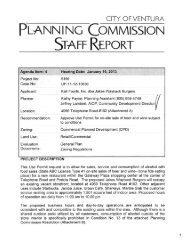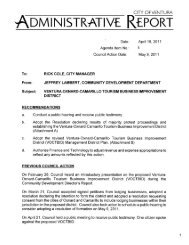Saticoy & Wells Community Plan & Development ... - City Of Ventura
Saticoy & Wells Community Plan & Development ... - City Of Ventura
Saticoy & Wells Community Plan & Development ... - City Of Ventura
Create successful ePaper yourself
Turn your PDF publications into a flip-book with our unique Google optimized e-Paper software.
<strong>Saticoy</strong> & <strong>Wells</strong> <strong>Community</strong> <strong>Plan</strong> and Code EIRSection 5.0 Growth Effects and Other CEQA Sectionsa portion of the emissions already occur, insofar as the occupants of the Project would beexpected to consume energy and drive, regardless of where they live.GHG Cumulative Significance. As discussed above under Methodology, CAPCOA (January2008) provided several approaches to consider potential cumulative significance of projects withrespect to GHGs. Table 5-5 shows CAPCOA’s suggested thresholds for GHG emissions. A zerothreshold approach can be considered based on the concept that climate change is a globalphenomenon in that all GHG emissions generated throughout the Earth contribute to it, and notcontrolling small source emissions would potentially neglect a major portion of the GHGinventory. However, the CEQA Guidelines also recognize that there may be a point where aproject’s contribution, although above zero, would not be a considerable contribution to thecumulative impact (CEQA Guidelines, Section 15130 (a)). Therefore, a threshold of greater than zerois considered more appropriate for the analysis of GHG emissions under CEQA.Based on CAPCOA suggested thresholds in Table 5-5, the Project’s contribution of about 64,870metric tons CDE/year would exceed four out of the five thresholds. However, as stated earlier,this conservative estimate assumes that all forecast development (1,833 residential units and270,625 sf of commercial retail space) would be developed within the 2025 planning horizon andthat all emissions are new. Finally, the proposed project involves development of the entire ProjectArea (which involves multiple individual development projects), whereas the CAPCOAthresholds are intended to apply to individual developments.It should also be noted that because the Project seeks to intensify development in already urbanenvironment by improving the interconnectivity among neighborhoods in the <strong>Saticoy</strong> and <strong>Wells</strong>communities, it would be expected to generally reduce reliance on the drive-alone automobile. Areduction in vehicle use and vehicle miles traveled can result in a reduction in fuel consumptionand in air pollutant emissions, including GHG emissions. The Climate Action Team, establishedby Executive Order S-3-05 has recommended strategies (Table 5-6) to reduce GHG emissions ata statewide level to meet the goals of the Executive Order (http://www.climatechange.ca.gov/climate_action_team/index.html). Several of these actions are already required by Californiaregulations. The Project’s consistency with the Climate Action Team Strategies is discussed inTable 5-6.The Project would be consistent with the measures indicated in the 2006 CAT Report.Consistency with this report illustrates that the Project would coincide with the State’sgreenhouse legislations and would not contribute to its inability to meet said goals.In addition, the <strong>City</strong> recognizes the value of “sustainable urbanism.” With the Project, the <strong>City</strong>strives to advance sustainable planning design practices to minimize the impacts of developmenton natural systems and processes. For example, the <strong>Community</strong> <strong>Plan</strong> includes the elements listedon page 5-21 that reduce its impact to global climate change through construction and operationalpractices that have reduced carbon footprints and contribute to a more sustainable community.5-16<strong>City</strong> of <strong>Ventura</strong>
















